Question: Dear Pastor Frank. I see that your article on Swimming Naked has disappeared with the old blog. Will you be bringing it back? I had some questions I wanted to ask you. How did forced nude swimming in the schools and the YMCA ever become such a widespread practice in conservative Christian America? I grew up in a religious family, after the time when there was nude swimming in the schools, although my father remembered it. But my grandfather wouldn’t even let the girls in our family swim in the public outdoor pools in the summer, where bathing suits were required, because he thought it was too immodest. Also, I have read some horror stories on sites that deal with the topic about how boys were treated by coaches and it’s not something I would want to participate in. When I ask men today if they would like to return to swimming nude, they say “it’s a gay thing.” So, basically, why were you interested in the topic and what point were you trying to make about swimming nude?
Frank answers: I don’t think I will be bringing back the original article on Swimming Naked. It elicited so much comment that it was difficult to keep up with it and be able to work on other articles for the blog. I even made two curated articles with the comments. But I’m willing to answer your questions since they address different issues than the ones that dominated the discussion on the original article.
First, a little background for those who didn’t read the original article. I wrote it in response to something said when I went back to my high school class of 1961 55th class reunion in 2016. We had a tour of beloved old Bennett High School in Buffalo, NY. When our tour guide (a retired male teacher) got to the renovated natatorium, he said, “You men will probably remember the barbaric practice of boys swimming nude.” I responded that I didn’t think it was barbaric. Swimming nude had a long history from ancient to modern times in Western civilization. It was standard practice in indoor pools in schools, clubs, and associations like the YMCA.

When I got home, I began doing the historical research. The point of my article was simply to illustrate that men and boys swimming naked (sometimes women and girls also) had been the practice down through the ages. Bathing suits were invented in the mid-19th century in Victorian England when men and women swam together on urban public beaches and in public outdoor pools to provide modesty for women. Women’s modesty also required protecting them from viewing naked men. For a long time in America it was considered indecent for men to show their nipples. This broke down when Hollywood’s leading men appeared bare chested on the silver screen. As for returning to the older practice of swimming nude, the Woodstock Music Festival in 1969 blew away the need for bathing suits as young men and women bathed nude in the lake.
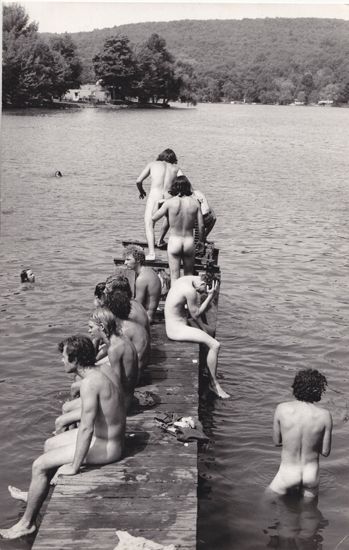
Skinny dipping remained a practice in more secluded areas in lakes and streams and, if anything, became more popular in the 1970s just when nude swimming was being phased out in the schools and YMCAs. It attracted college students, not just hippies.
Also in the late 1960s/early 1970s, co-ed swimming parties were scheduled on some college campuses. Harvard College and Antioch College in Ohio scheduled such parties. Co-ed swimming was featured in the film version of Robert Rimmer’s 1966 novel, The Harrad Experiment (1973), which was actually occurring on some college campuses.
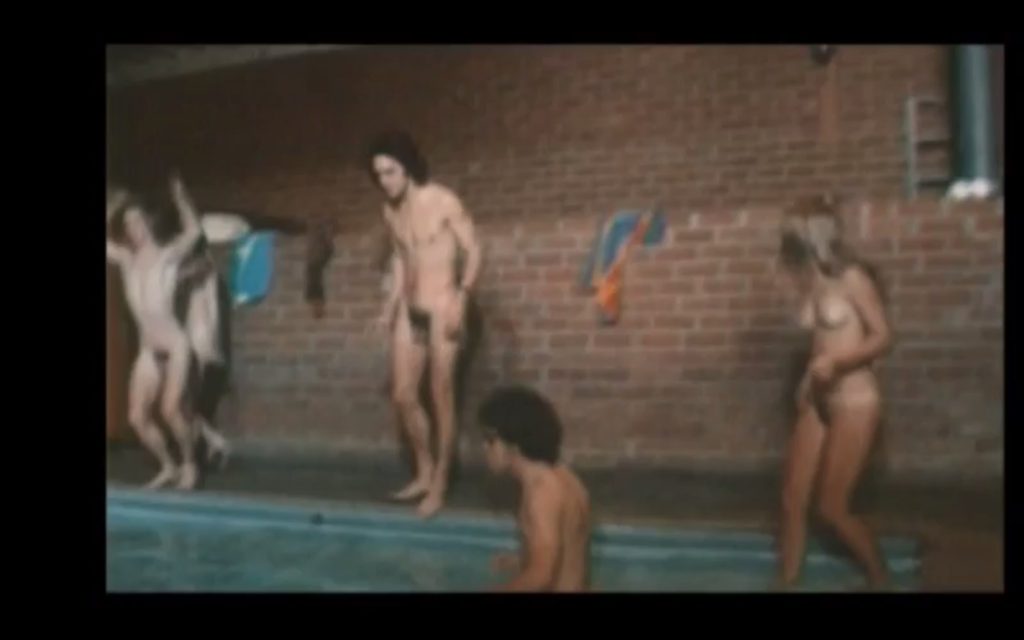
When indoor pools were built in the 1880s the practice of swimming nude outdoors continued indoors. There were some health benefits to it. Showering nude before entering the pool cleansed the body and swimming nude avoided wearing bathing suits (cotton in those days) that contained bacteria. These issues were pointed out in the American Public Health Association’s guidelines recommending nude showering and swimming in 1926. Guidance also made a concession for female modesty with its bathing suit recommendations.
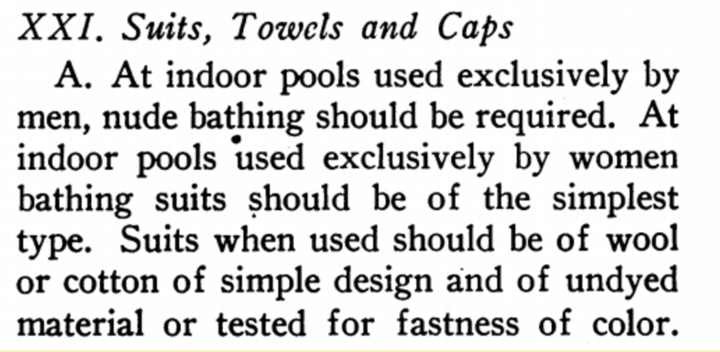
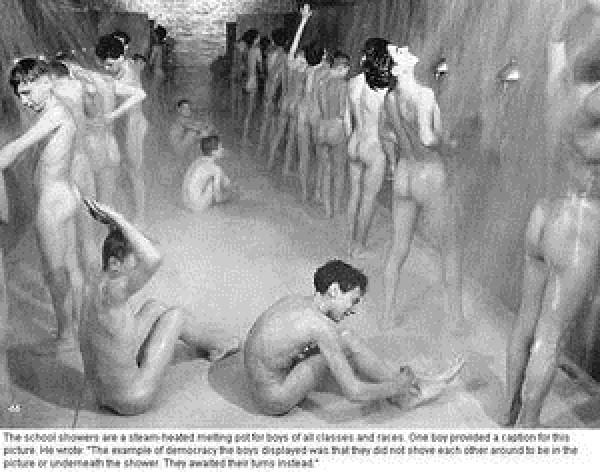
These recommendations were omitted in the 1962 guidelines. Thereafter pressure was on (mostly from mothers) to provide for male modesty, with school boards still opting to preserve the tradition of boys swimming nude. It was really Title IX, that provided for equal female access to physical education and sports, and the YMCAs opening membership to girls and women, that spelled the end of boys swimming nude in schools and the YMCA. But here is a newspaper report from the Janesville Daily Gazette dated Thursday, February 2, 1967 of a discussion at a school board meeting and the decision of the board to maintain the tradition of boys swimming nude.

Beyond establishing the fact that boys swam nude in public schools before the 1970s, the first big issue that my articles addressed was that many people simply didn’t believe that nude swimming in the public schools and the YMCAs had happened. I discovered that even young program staff persons at my YMCA didn’t realize that from 1885, when the first pool was built by the Y to provide swimming lessons in response to the high number of urban boys who died by drowning, boys and men swam and sometimes exercised nude at Ys. Here was a historic practice that is a living memory in men who are now in their 70s and older that has been suppressed and denied. The fact that my article had about 75,000 page views and hundreds of comments, mostly from senior men who remembered the practice, indicates to me that they are interested in discussing their experiences. I had no idea when I wrote the article that it would elicit this kind of response.

Another couple of issues arose among the comments. There was a big debate over whether boys ever swam nude in front of woman and girls. Did the naked boys sometimes have female instructors and coaches? Did they swim naked in public swimming competitions with females among the monitors and spectators? Some commentators were freaked out by the very idea. For the most part, no. But we had reliable commentators who testified that they (women) did coach naked boys and a couple of commentators testified that in Michigan in the 1960s they experienced female audiences as swimmers or witnessed female attendance at swimming meets in their high school. There were hundreds of comments about this issue.
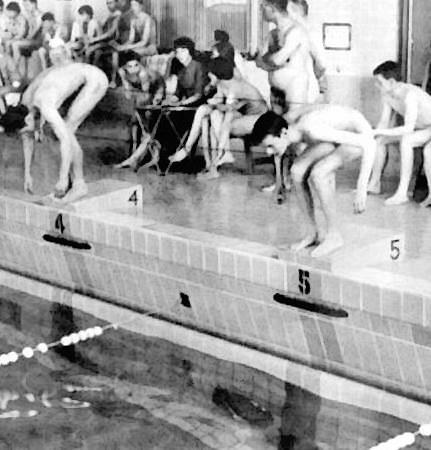
There were nearly as many comments about whether some of the vintage photos showing boys swimming naked were photoshopped. In some instances, I could see that it happened because I found photos that showed genitals and the same photos with the boys in swimming suits. The assumption was that the penis was added. Well, it could also have been the case that the bathing suit was added so that the boy swimmers could be shown on the internet. One commentator reported that when he went to the YMCA summer camp, swimming was nude. But on family day, when photos were likely to be taken by parents, the waterfront director got swimming suits out of a box for the boys to wear. After the parents left, the suits were collected and put back in the box. Boys swam nude at YMCA camps as well as in the YMCA indoor pools

These issues were all very interesting, and we went around and around on them. But I don’t want to go around and around again with hundreds of comments to administer and monitor on this new blog. So, no, I’m not going to re-post the original article. Those who want to get into these debates will have to do so on other blog sites.
One issue that shows up on the internet are discussions about swimming naked that devolve into lurid sexual narratives. These are certainly fabricated stories and I was very cautious about allowing comments based on such tales. The presence of such stories made it difficult to sort out such issues as boys being seen nude by girls at swim meets or girls themselves swimming nude.
For this reason I would advise our questioner to also exercise caution in accepting the veracity of horror stories about how boys were treated by coaches. I can accept that there may have been coaches who shamed boys because of their lack of swimming ability, but not because they got an erection. Bullying by classmates undoubtedly occurred, although I didn’t experience it. The fact that these things happened in some schools doesn’t mean it went with the territory.
I can testify that our swimming coach, Mr. Rudolf Heis, was pretty strict in his instruction. But I did not experience any physical or mental punishment of the boys, like paddling or shaming. He didn’t carry a paddle. He kept in his hand a long pole such as a life guard would use to pull a struggling kid out of the water. He was also pretty blunt in telling us freshmen boys up front that we would be nude, that we all had the same equipment, that at age 14 we were developing on different time tables, and he didn’t want to see any harassing. By harassing he was probably referring to comments about penis size or pointing out erections.
One of the questions frequently asked by those curious about the practice of boys swimming nude is if the boys got erections. I don’t remember this, but we probably did, for example, when undressing and going into the hot showers. But penises shriveled up when they hit the cold water. In any event, erections are nothing to be ashamed of.
In the 1950s, we boys simply took it for granted that this was the tradition. I had already had several nude swimming experiences before my freshman high school swimming class. The most fun I had was wrestling with my best friend Gary in a game of trying to dunk the other during the occasional free times in the pool at the end of a class session. It didn’t occur to us that we were wrestling nude.

In my experiences I remember boys being pretty relaxed about being naked with one another in the pool, in the showers, and in the locker room. I remember a district Boy Scout swimming night at a YMCA when I was about twelve, partly to work on swimming requirements, but also to have a good time in the water. According to YMCA requirements, we were all nude. I’m still relaxed about male social nudity today.
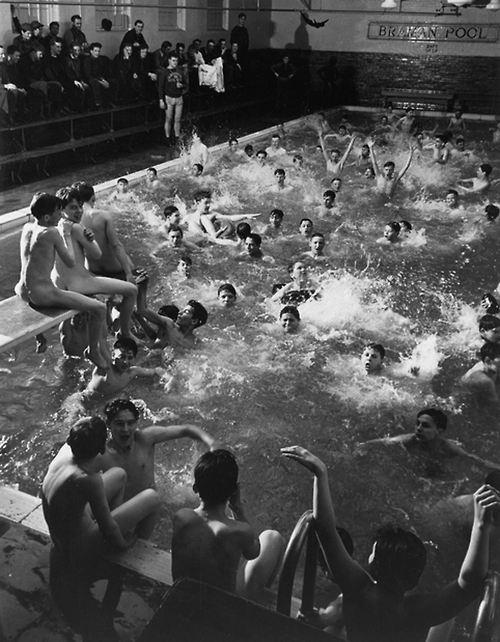
In terms of how this happened in so-called Christian America, there’s nothing in Christian teaching that regards nudity as morally wrong. It’s how we come into the world. Clothing is a consequence of the fall into sin. Modesty in the New Testament had more to do with women not wearing jewelry than with being naked. I would point out that the Young Men’s Christian Association, which was a pioneer in teaching urban boys how to swim, was founded as an evangelical organization. As a matter of fact, we learned from comments on my blog that more northern schools had swimming pools than southern schools. Across the upper Midwest there were many Catholics and Lutherans who didn’t have puritan ideas about the body. The South with its Baptists and other conservative denominations did not have so many swimming pools. After 1970, when many new schools were built across the country that included swimming pools, the custom of boys swimming naked was being phased out in schools that practiced it because of Title IX in 1972, which mandated and introduced co-ed physical education in the public schools.

In terms of my interest in the subject: males today have all kinds of body issues that don’t get discussed. I tried to bring out some of these in the articles dealing with swimming naked and it unleashed the flood gates of men who wanted to discuss the damage done to them, especially by their religious upbringing. Many correspondents expressed gratitude that a pastor has been so open and positive about discussing issues of masculinity and sexuality, which are all too often rightly called toxic, and the healthy role of nudity in one’s life.
I’m not advocating that boys today should swim nude in public. That’s not going to happen. (For one thing, there are too many iphone cameras available.) But there were some values to the experiences most of us had when swimming naked that made us more comfortable in our bodies than the younger generations today who won’t even shower after gym class. Boys and young men today don’t want to be exposed naked to other males in gym locker rooms. Oldsters note that young men do the “towel dance” to change clothes in gym locker rooms.

Social Norms
Body changes during puberty and adolescence affect our self-image, which is based primarily on our body image. One’s body image is shaped by social norms and cultural upbringing. From an early age we are taught what is proper bodily behavior, and in a clothed society strict boundaries are set for public nakedness. These factors dictate how we feel when our naked body is exposed. When and where is nakedness or nudity accepted and when and where is it considered a breaking of social norms? There may not have been any consistency in the norms.
For men of my vintage, nakedness was an acceptable social norm if boys were showering and swimming together in indoor pools. It was also considered okay to swim naked in secluded outdoors lakes and streams if girls weren’t around. By and large, these venues for being naked with other males are closed off today (although we are seeing a proliferation of “clothing optional” beaches and an interest in naturism). Lacking situations to counter the inculcated social norm that we should not be naked (i.e., show one’s “private parts”) in public, most boys today have acquired such a sense of modesty that they don’t even like to be naked in front of one another in locker rooms and showers. These millennials had no experience of being naked in front of other men. Without the draft, they don’t experience it in military barracks.
Was Naked Swimming a Gay Thing?
Finally, as you say, the accusation is often made today that swimming naked is a gay thing. Ironically, back in the 1950s and 1960s boys who were shy about undressing in front of other boys were regarded as “queer.” But by the 1990s boys who wanted to swim naked were regarded as a “gay.” I don’t think that was a major reason why the practice of naked swimming began to cease in the 1970s and definitely by the 1980s. But I do think it contributed to the reluctance of boys to shower after physical education classes.
Was there an element of homoeroticism in boys swimming naked? Undoubtedly. But that doesn’t mean naked swimming is a gay thing. The Kinsey Report on Male Sexuality demonstrated that relatively few males were exclusively homosexual or heterosexual. Responses to questions indicated that many men had experienced one or more same-sex encounters. Only a small percentage rated their sexual attraction as only same-sex or opposite-sex. But in the wake of gay liberation, and the reaction to the greater presence of homosexuals in public life, homophobia gained traction beginning in the 1980s and definitely by the 1990s. Men and boys feared being identified as gay. They sought to demonstrate their straightness by using homosexual sexual slurs against boys perceived as gay. Fear of being “hit on” by gays in showers and locker rooms contributed to a desire not to be naked in these venues. But gay boys also feared being exposed, for example, by having an erection in the shower or locker room and being harassed for it by other boys. Boys became homophobic—afraid of men. Incidents of sexual abuse of boys by coaches or other boys also stoked these fears. Even today, we are not as sexually liberated as we like to think. In fact, I think we are experiencing a new puritanism.
To be uncomfortable or dissatisfied with our bodies is to be uncomfortable or dissatisfied with ourselves because we are bodies as well as souls. To be ill-at-ease in our bodies or ashamed of our bodies is a cramped way to live. If we can experience being comfortable being naked and unashamed with others, we will also be more open with others in life and more willing to be vulnerable in love. These are the kind of issues I’m interested in.
Pastor Frank
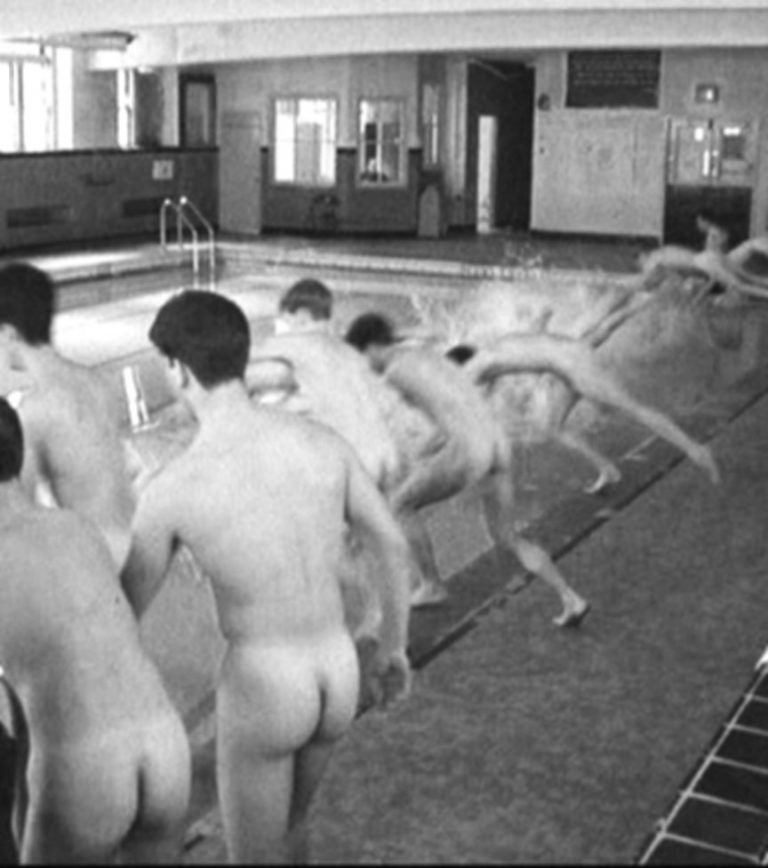
The painting above this post is “Boys Swimming in a Lake” by Addison Thomas Millar (1860-1913)

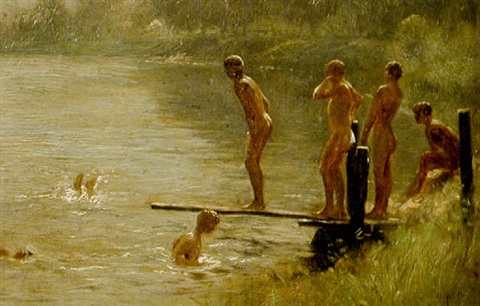




Hi Pastor Frank,
I’m a millennial male and I’ve always been interested in the sociology of clothing and nudity and would like to, at some point, study the topic as a Ph.D. student in sociology. Anyways, in reading the myriad of comments your posts about these topics received, there was speculation about the rationale behind a particular practice that’s near-universal among guys of my generation: the “towel dance”. Among commenters, who I assume skewed towards the Baby Boomer and Silent generations, the consensus was that millennials (and probably zoomers as well) do the towel dance “because they’re insecure about their penis size”. This never sat right with me because never once growing up did I hear anyone express insecurity about that. But that might just be because people don’t say out loud what they’re insecure about. That’s how insecurities work. There was, however, a lot of insecurity about sexual orientation. Accusations would provoke emphatic denials, the word “gay” became a pejorative, and yes, the f-slur was sometimes used. But even though millennials may be more insecure about penis size than previous generations, I believe that the norm change precipitates the insecurity, not the other way around. Here’s how that happens:
1. Default towards inoffensiveness
Generally speaking, when people don’t know what the norms are, people will default to doing that which is least likely to offend others. For example, many gyms have no policy on whether working out shirtless is acceptable. But because you’re guaranteed to not offend anyone if you do wear a shirt, but might offend someone if you go shirtless, the default choice is to wear a shirt.
2. Trend towards conformity
Rather than tolerating increasingly diverse behaviors as acceptable, people tend to settle upon only one or a few behaviors that are acceptable that everyone must conform to. If a default is established, behavior will increasingly conform to the default. Continuing on the gym example, people will default to wearing a shirt until everyone wears a shirt all the time and becomes the only acceptable way to dress.
3. Establishment of a new decency standard
This step, particular to clothing standards, happens after the norm is established. Deviations from the norm gain a sexual meaning and when the norm is broken it becomes an act of indecency. “Indecency” meaning thrusting one’s sexuality on non-consenting people. To further elaborate, the “indecent act” ends up saying something about both the person committing the act as well as those subject to it. To continue the gym analogy again, for men who are insecure about their sexual orientation, they’ll see a shirtless patron as gay and indecent. Gay because the person is in view of other male patrons and indecent because of the sexual meaning that style of dress acquired. For the insecure person, they become afraid that the mere sight of the shirtless patron “makes them gay”, so they become offended.
For the towel dance, what happened, was all three of these steps. Step 1: Between “bearing it all” and the “towel dance”, you won’t offend anyone by doing the towel dance, so it becomes the inoffensive default. Step 2: After several years, it becomes THE way to change in a locker room. Step 3: Then, with everyone behaving this way in the locker room, “bearing it all” becomes sexualized and indecent. So when someone “bears it all” they’re seen as being sexual towards the other male patrons and is therefor “gay” and behaving indecently.
But what about penis size? I think we get a sense of what’s normal through experience. While not happening on a conscious level, I think there’s a part of our brains that builds a statistical model of what about a person’s body is normal. It’s the reason we can tell the difference between something that’s at the far ends of normal and an actual medical abnormality. So when the norm changes and deprives us of this information, we end up getting our sense of “normal” from other sources, like porn, which definitely are not normal. While it sounds reasonable that simply telling 7th graders in a health/sex ed class what normal is, that’s just not how our brains work. So despite telling 7th graders that they’re normal, they don’t believe it because it’s not what they’re seeing “in their everyday life” (porn). All of this to say, the norm change is what led to the insecurity about penis size, and the norm change reflects insecurity about sexual orientation and decency. There’s a quote by Alejandro Jodorowsky that describes this phenomena perfectly: “Birds born in a cage think flying is an illness.”
Thank you very much for this social analysis. I guess older men who walk around naked in gym locker rooms fit into a different category. I was actually corresponding with a 24-year old who developed a gym buddy relationship with an older married man who convinced the young man to shower naked. The young man removed his towel, sprouted an erection, and became very embarrassed and apologetic. The older man told him he should be proud of his manhood. Thereafter the young man became more accustomed to nakedness and occasional erections. I wish you well in your PhD dissertation project.
Glad to see this topic still being discussed. I’m too young to have experienced institutional nude swimming myself, but I find it an interesting topic, especially since I attended a university that required nude swimming in the 1960s (40 years before I attended) and because at least one male relative experienced it growing up.
I think what makes institutional nude swimming noteworthy and why it continues to generate so much interest online is that it reflects changing cultural assumptions about the male body and privacy. The French philosopher Michel Foucault spoke of discursive formations (what can be said or known about a specific topic at a given time). It’s shocking to us now, but in the era of nude swimming, the nude male body was not regarded as sexual. It was just a nude body. The end of institutional nude swimming seems to coincide with the sexualization of the male body and other cultural changes to our understanding of sexuality in the U.S. in the 1970s.
My discomfort with the topic seems to be that a lot (though certainly not all) of websites which discuss nude swimming talk it through a very sexualized lens. Such stories are likely fictional despite purporting otherwise and probably not at all reflective of what it was like for the people who really experienced it. As a result, it’s difficult to discuss the topic with others without seeming “perverted.” All of this is unfortunate, because i do think it’s an interesting topic that deserves to be historically preserved.
Hunter
I think you are on to something. I have noticed that some of the stories elsewhere come across as soft core porn. It is already hard enough to discuss this topic.
My perception is, while I was growing up during the 1950s and 1960s, there was a sort of unspoken struggle between those in the Establishment who were still quietly sympathetic to traditional ways and the more vocal advocates of prudish Puritanical / Victorian values.
The prudes won, in part, by falsely portraying supporters of male immodesty as sexual perverts. During the 1960s and 1970s, there were tales about strange exhibitionist men clad in trench coats. Then, in the 1980s and 1990s, child sex abuse scandals; which while tragic, were hyped quit a bit out of proportion. Now, in 2022, any PE teacher who made boys swim naked would likely be in big trouble.
I was in high school from 1959 to 1963, and even though we didn’t have any swimming we did have communal showers in the locker room. This was considered no big deal. I wasn’t aware of any schools even having swim classes, much less swimming nude in them. In my senior year shop class the teacher did tell about the YMCA requiring swimming to be conducted in the nude. I have a difficult time though when I read accounts of boys swimming nude in front of female spectators. I do believe a lot of these recollections. As a 76 year old man I don’t find this to be an undesirable thing, to the contrary, the idea sounds wonderful, and I think that our society would be better if that was the way things were now. Our society has become very mixed up regarding nudity, and the loss of nude males swimming in front of females is one of the major blows to mental health in the United States.
I had a related discussion a while back with a slightly younger business colleague and would appreciate your input. He attended high school in an urban area during the middle 1980s. He does admit, based on evidence, that some schools and YMCAs once required boys to swim nude in male only swimming classes, for strictly sanitary reasons. However, he insists it was likely rare, limited to larger, urban areas and ended quickly once modern sanitation methods became available. His position was based on a premise that the further back we peer into time, the American people were more conservative, Moreover, he assumed rural areas are more conservative than urban areas. Note his apparent association of rural conservatism with prudishness about nudity.
My experience contradicts that. I was born in a rural area in the early 1950s. The year I turned 8, we moved to an urban area. Modesty, in regard to nudity, for men and boys was not really a huge thing either place. Both had a double standard, with more acceptance of male immodesty, and a stricter requirement for female modesty. Overall though, my impression is the 1950s rural folks had a more relaxed, less prudish, more wholesome attitude toward nudity.
Memories from more than 60 years ago are admittedly sketchy. That said, before the move, I vaguely recall boys of all ages, or at least through early teens, swimming naked at social outings with family and friends. The girls wore age appropriate swimwear. Preschool age girls did not need a suit. Another more clearly recalled example is girls younger than age 10 or so could play outside without a shirt. Not so after the move. Also, before the move, my brothers and I felt perfectly comfortable walking around the house naked in front of our sisters and our / their friends. After the move, we had to be cautious about guests.
In the urban area, there was zero tolerance of any public nudity, including topless little girls, Private nudity, especially same sex nudity, was another thing. Same sex male nudity was actually officially encouraged in practice. Boys changed clothes and took communal showers in locker rooms, for physical education classes and sports, at the junior high and high schools. Men and boys did the same in bathhouses at public waterfronts and municipal pools. The changing facilities for men and boys were always wide open and communal, while those for women and girls were more secure and frequently had private stalls.
Shortly after the move, we joined a local YMCA. At the time it was male only with nudity required in the pool. I took formal lessons for a couple years. The pool had an observation deck. Sometimes family and friends, including sisters and female friends, would hang out and watch informally. No one seemed to mind. On formal family nights, or when there were sessions open to the public, they made us wear swimsuits. Around 1966 or so, they started admitting women, so appropriate swimwear became required all the time.
The junior high school I attended had a pool and mandatory swim classes. As with all physical education back then, boys and girls classes were separated. Boys swam naked. My understanding is girls wore tank style suits. For the 1965/1966 school year, due to pressure from moms, they made swimsuits for boys optional. Most of the boys opted to swim naked. By the middle 1970s, the district went to coeducational physical education, thus ending naked swimming.
When swimsuits became optional for boys’ swim class at my school, I talked it over with my parents. My dad said he could not understand why anyone would wear one given a choice. He told me that when he grew up in a rural area during the 1920s and 1930s, boys swam naked in the rivers and lakes. He related that he had once been on a high school swim team. At some point, due to pressure from outside groups, they were required to wear suits for public meets. They hated it because the trunk style swimsuits were very uncomfortable and slowed them down. He added it was a different, more innocent time. It hadn’t occured to them to be embarrassed about swimming naked in front of parents, siblings, and classmates of both sexes.
I am not going to call googling “research.” I did search the web for more information. It appears that beginning with the late colonial era through the late 1800s it was fairly common for male immigrant laborers to bathe naked in coastal waters, lakes, and rivers. This was possibly initially for sanitation purposes, perhaps eventually for recreation. As those areas areas became more densely populated and urbanized, the practice came into conflict with the Puritanical / Victorian values of the middle and upper classes. The first public bathhouses and pools were apparently built to drive the naked men and boys indoors. The practice of outdoor male naked swimming may have continued in the more remote, rural, backwoods areas. If true, that narrative fits with my anecdotal evidence.
I also came across stories by men who said they were traumatized by having to swim naked with other boys at school. Good grief. Life can be challenging.
Dear Calder, my family used to visit for a week a family in a small town in Western new York in the mid-1950s whom my father knew from working on their farm during the Great Depression. They had son called Buster who was a year and a half older than me. When I was twelve (1955) he introduced me to sleeping naked. When we brought him back to Buffalo for a week he felt a need to lead my younger brother and me on a merry naked romp through our house one day when my mother and sister were out shopping. The next year (1956) we visited a farm family who had a son who was 15 or 16. He invited me to go swimming in the nearby creek. I didn’t have a bathing suit with me, but he said we could swim naked as long as the girls didn’t come. The summer I was 15, I spent a week with three other Scout friends in a wilderness valley with a fast flowing creek. We discovered an ideal swimming hole and swam naked in it every day. We were used to swimming naked from freshman high school swimming class. When I was 20 (1963), I visited a young man I had met who lived in the Blue Ridge Mountains of Virginia. We were walking along the Shenandoah River on a warm summer evening and he said “let’s go swimming,” and we just stripped naked and went into the river. I relate these stories because they corroborate your experience and research that swimming naked was quite acceptable for boys in rural America. In the city public pool we went to in the summer, showering nude was required and we changed in a locker room. But outdoor nudity was not approved in the urban environment.
It’s fascinating what you report about immigrant workers since nude swimming was much more prevalent in Europe and still is. I believe the development of urban beaches in the second half of the 19th century led to the requirement that men wear bathing suits and the development of bathhouses with changing facilities. (I think this actually began in Victorian England.) BTW, my wife, who grew up in a small town in north Texas, told me that girls could be outdoors shirtless in the summer up to about age 10 or, I suppose, when they began showing breast development. Thanks for sharing your recollections and “research.”
I have also done research on these topics, being an editor of Wikipedia contributing to many of the nudity articles. I do not see two of the significant references here:
* A New York Times article from 1909 describing a citywide school competition at which the 80 lb division requested and were allowed to swim nude, obviously before a large mixed audience, because their suits slowed them down.
* A case of girls swimming nude at two elementary and one middle school in Highland Park, MI in 1947, which made the news only because some middle school mothers protested. The board consented to having suits, but stated that girls swimming nude with their peers raised “no moral issues”. The elementary schools continued to allow nudity for girls. It was optional, but all wanted to be nude.
Thanks for the references, Joe. I didn’t have those references in my longer article either. This post was intended to respond to the specific questions asked about nude swimming in religiously conservative America and reported instances of bullying by teachers as well as by other students. I preceded those answers with a summary of the discussion on “Frank Answers About Naked Swimming,” which was on the old Frank-Answers.com blog, by way of indicating that I don’t want to go around and around on those issues. Your references would be helpful in the discussion of whether boys swam naked in front of women, the thought of which seems to terrorize men. But additional testimony to that practice won’t reduce their anxieties about it. LOL
I turned 20 a week after Woodstock. Although I experienced nude swim class at the U of MD in 1968, I am part of the “skinny-dip” generation, unconcerned with being naked anywhere. (I am an artist who draws nude models, and was a model in college.) What interests me is how we went from progress toward naturist sensibilities in the 70s to sexualizing all nudity, even of children, in the 80s.
My own childhood memories of the beaches on the Chesapeake Bay are that prepubescent nudity was acceptable for boys and girls, with variations. All toddlers could be naked. Older boys might be naked also, but at some point girls wore bottoms, which was the case for my sisters. Perhaps it is these childhood experiences, some so early that they are unconscious, that made many of my generation more open to nudity than before or since.
However, innocence was based upon a fiction of children having no sexuality at all before puberty. What is needed is acceptance that nudity may be sexual, but is healthy and normal with age-appropriate behaviors at each stage of life. Going through these stages without learning shame is essential. What prevents this is a combination of parents who do think sex is shameful, and others who think kids are fragile, and need to be protected from any negative feelings. Parental anxiety is fueling pedophilia panic. Kids need to be protected, but not coddled. Not showering with peers after gym comes from the same trend as helicopter parenting; such as thinking kids can’t walk unsupervised in their own neighborhoods.
Thanks, Joe. I appreciate your sharing of your experiences of nude swimming and modeling nude and painting nudes. You might find this post interesting, and you are welcome to comment. https://frank-answers.com/frank-answers-about-nudity-and-pornography/